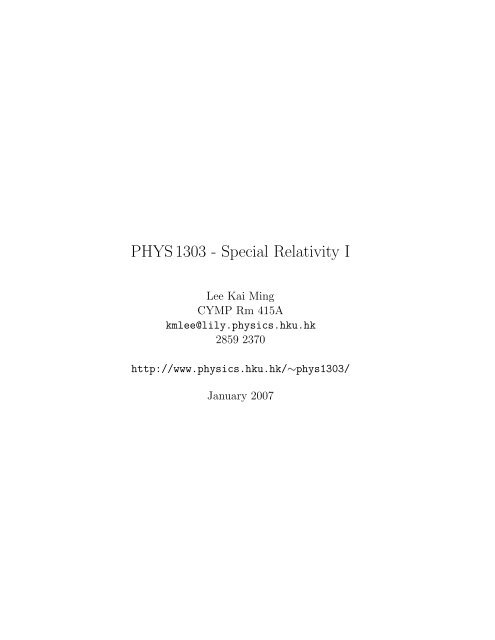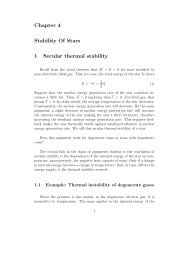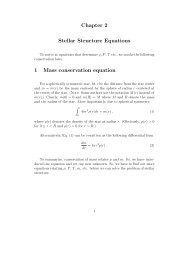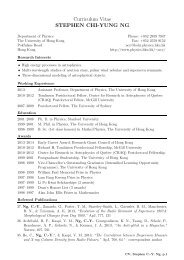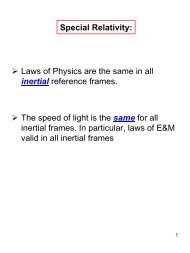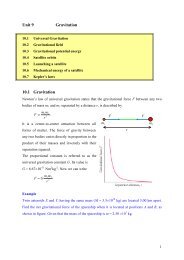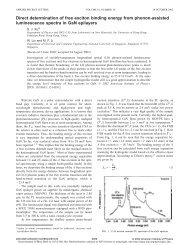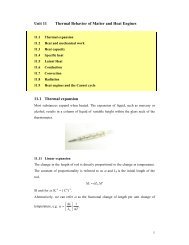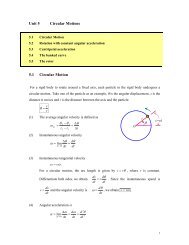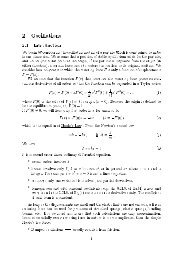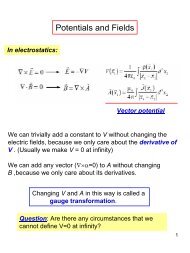here - Department of Physics, HKU
here - Department of Physics, HKU
here - Department of Physics, HKU
You also want an ePaper? Increase the reach of your titles
YUMPU automatically turns print PDFs into web optimized ePapers that Google loves.
PHYS 1303 - Special Relativity I<br />
Lee Kai Ming<br />
CYMP Rm 415A<br />
kmlee@lily.physics.hku.hk<br />
2859 2370<br />
http://www.physics.hku.hk/∼phys1303/<br />
January 2007
Contents<br />
1 Pre-Special Relativity <strong>Physics</strong> 1<br />
1.1 Newtonian Mechanics . . . . . . . . . . . . . . . . . . . . . . . 1<br />
1.2 Galilean Transformations . . . . . . . . . . . . . . . . . . . . . 2<br />
1.2.1 Inertial Frames . . . . . . . . . . . . . . . . . . . . . . 3<br />
1.2.2 Events . . . . . . . . . . . . . . . . . . . . . . . . . . . 3<br />
1.3 Light . . . . . . . . . . . . . . . . . . . . . . . . . . . . . . . . 6<br />
2 Special Relativity 8<br />
2.1 Michelson-Morley Experiment . . . . . . . . . . . . . . . . . . 8<br />
2.2 Basic Postulates . . . . . . . . . . . . . . . . . . . . . . . . . . 11<br />
2.3 Transverse Distances . . . . . . . . . . . . . . . . . . . . . . . 11<br />
2.4 Time Dilation . . . . . . . . . . . . . . . . . . . . . . . . . . . 12<br />
2.5 Length Contraction . . . . . . . . . . . . . . . . . . . . . . . . 13<br />
3 Lorentz Transformations 16<br />
3.1 Lorentz Transformation . . . . . . . . . . . . . . . . . . . . . . 16<br />
3.2 Simultaneity . . . . . . . . . . . . . . . . . . . . . . . . . . . . 19<br />
3.3 Addition <strong>of</strong> Velocities . . . . . . . . . . . . . . . . . . . . . . . 22<br />
3.4 Energy and Momentum . . . . . . . . . . . . . . . . . . . . . . 23<br />
4 Relativistic Kinematics 27<br />
4.1 Relativistic Doppler Effect . . . . . . . . . . . . . . . . . . . . 27<br />
4.2 Conservation <strong>of</strong> Energy and Momentum . . . . . . . . . . . . 29<br />
4.3 Four Vectors . . . . . . . . . . . . . . . . . . . . . . . . . . . . 31<br />
5 Paradoxes 33<br />
5.1 Twin Paradox . . . . . . . . . . . . . . . . . . . . . . . . . . . 33<br />
5.2 Pole and Barn Paradox . . . . . . . . . . . . . . . . . . . . . . 35<br />
5.3 An Illusion <strong>of</strong> Superluminal Motion . . . . . . . . . . . . . . . 36<br />
Index 38<br />
i
Chapter 1<br />
Pre-Special Relativity <strong>Physics</strong><br />
We will first review some relevant topics before relativity was discovered.<br />
The most important section is the one about Galilean transformations. The<br />
readers should already know it well, although maybe do not know the name.<br />
We will find in later chapters that these concepts are very important, but not<br />
correct. In particular, in Galilean point <strong>of</strong> view, space and time are absolute,<br />
in a sense that will be explained in the text. However, this is no longer true<br />
in special relativity, which means that space and time are not absolute in<br />
nature.<br />
1.1 Newtonian Mechanics<br />
We will briefly review the Newton’s laws in this section. The readers are<br />
assumed to know the material well. This section only serves as a reminder.<br />
The first law <strong>of</strong> mechanics describes the resistance <strong>of</strong> matter to change<br />
in its state <strong>of</strong> motion: A body in motion will remain in motion, unless it is<br />
acted upon by some external force.<br />
Newton’s formulation <strong>of</strong> the second law is the familiar<br />
F = ma = m ˙v (1.1)<br />
w<strong>here</strong> F is the force vector, m is the mass <strong>of</strong> an object and a is the acceleration<br />
vector. The mass in this equation is the inertial mass, which relates the<br />
response <strong>of</strong> the body to external force. The acceleration is the rate <strong>of</strong> change<br />
<strong>of</strong> the velocity. Velocity describes both the speed and the direction <strong>of</strong> the<br />
motion. Thus, sometime the acceleration is non-zero even if the speed <strong>of</strong> the<br />
body remains constant.<br />
Eq. (1.1) is valid only in an inertial frame. This is a very important<br />
concept and we will discuss it much more in Subsection 1.2.1.<br />
The third law states that whenever t<strong>here</strong> is an action, t<strong>here</strong> will be an<br />
equal in magnitude but opposite in direction reaction. For example, we feel<br />
1
CHAPTER 1. PRE-SPECIAL RELATIVITY PHYSICS 2<br />
the gravitational attraction <strong>of</strong> the Earth pulling us down, at the same time,<br />
t<strong>here</strong> is a force <strong>of</strong> the same strength pulling the Earth “up.”<br />
Momentum, or linear momentum, <strong>of</strong> a particle is defined as the product<br />
Hence, the Newton’s second law can be re-stated as<br />
p = mv . (1.2)<br />
F = dp<br />
dt . (1.3)<br />
This is the form that will be generalized to special relativity. We found that<br />
in the absence <strong>of</strong> any external force, by Eq. (1.1), the total momentum <strong>of</strong> a<br />
system remains constant. This is the conservation <strong>of</strong> momentum.<br />
The addition <strong>of</strong> velocities in classical mechanics is very simple. For example,<br />
if a train is moving with velocity v t relative to the station and a ball<br />
is moving with velocity v b relative to the train, then relative to the station,<br />
the ball is moving with velocity v t + v b .<br />
The kinetic energy <strong>of</strong> a particle is given by<br />
K. E. = 1 2 mv2 = p2<br />
2m<br />
(1.4)<br />
w<strong>here</strong> v and p are the magnitude <strong>of</strong> velocity and momentum respectively. If<br />
we want to change the velocity <strong>of</strong> the particle, a force must act on it. The<br />
change <strong>of</strong> kinetic energy is equal to the work done W, which, for constant<br />
force, is the dot product <strong>of</strong> the force vector F and the displacement vector r<br />
<strong>of</strong> the particle<br />
W = F · r . (1.5)<br />
If the force is not constant, consider the infinitesimal small displacement<br />
dr, which means, consider the particle moves from position r to r + dr, the<br />
contribution to the work done is F · dr. The total work done is to integrate<br />
W =<br />
∫ r1<br />
r 0<br />
F · dr (1.6)<br />
w<strong>here</strong> r 0 and r 1 are the initial and final points.<br />
Apart from the kinetic energy, t<strong>here</strong> are other kinds <strong>of</strong> energies, like the<br />
potential energy, chemical energy or nuclear energy. If we sum up all kinds <strong>of</strong><br />
energies in an isolated system, the total energy also remains constant. This<br />
is the principle <strong>of</strong> conservation <strong>of</strong> energy.<br />
1.2 Galilean Transformations<br />
We will discuss Galilean transformations after we talk about two important<br />
concepts.
CHAPTER 1. PRE-SPECIAL RELATIVITY PHYSICS 3<br />
y<br />
O<br />
x<br />
1.2.1 Inertial Frames<br />
z<br />
Figure 1.1: An inertial frame.<br />
Eq. (1.1) is valid only in an inertial frame. What is an inertial frame? A<br />
reference frame or just a frame is a standard to which motion and other mechanical<br />
quantities can be measured. Usually, it means a coordinate system<br />
<strong>of</strong> space and time. Note that the coordinate system does not have to be<br />
“linear.” For example, a useful coordinate system on the surface <strong>of</strong> a sp<strong>here</strong><br />
is non-linear. A well known example is the longitude and latitude on the<br />
Earth.<br />
In some textbooks, an inertial frame is defined as the frame on which<br />
Eq. (1.1) is valid. This is, <strong>of</strong> course, not a good definition. In practice, an<br />
inertial frame can be defined as any frame at rest or in constant velocity with<br />
respect to the fixed stars. (In contrast, for example, a rotating frame, like<br />
the surface <strong>of</strong> the earth, is not in constant velocity with respect to the fixed<br />
stars.) This means, we have to choose some initial time as t = 0, a point<br />
in space as the origin O, then three perpendicular directions as directions<br />
<strong>of</strong> the three axes, Fig. 1.1. The origin O is allowed to move with constant<br />
velocity with respect to the far away fixed stars, but the axes are not allowed<br />
to rotate with respect to the stars.<br />
After we find one inertial frame, any Cartesian coordinate system moving<br />
with constant velocity and no rotation with respect to the inertial frame is<br />
also an inertial frame. If we are careful enough, we can find by experiments<br />
that the “rest” frame on the Earth is not an inertial frame.<br />
In this course, we will only consider inertial frames. Hence, we usually will<br />
only speak about frames, instead <strong>of</strong> the more correct term inertial frames.<br />
1.2.2 Events<br />
In common language, an event is something happened at some place at some<br />
time. In special relativity, an event means exactly this: a point in space<br />
and time. Thus, we have to specify both the space coordinates and time
CHAPTER 1. PRE-SPECIAL RELATIVITY PHYSICS 4<br />
y<br />
y’<br />
O<br />
O’<br />
x<br />
x’<br />
z z’<br />
Figure 1.2: The relation between two frames.<br />
coordinate to indicate an event. To visualize it, we usually speak <strong>of</strong> the<br />
explosion <strong>of</strong> a bomb or the moment when and w<strong>here</strong> we turn on a flashlight.<br />
Note that the same event could have different coordinates with respect to<br />
different frames, while t<strong>here</strong> is no disagreement on the nature <strong>of</strong> the event.<br />
For example, everyone will agree whether it is an explosion <strong>of</strong> a bomb or only<br />
the light-up <strong>of</strong> a flashlight.<br />
We will talk about the Galilean transformations after we discuss a few<br />
more terms. An observer is a being that makes measurements <strong>of</strong>, among<br />
others, lengths and durations. In relativity, we have to be very careful about<br />
the motion <strong>of</strong> the observer. The rest frame (or co-moving frame) <strong>of</strong> a body<br />
or an observer is the frame w<strong>here</strong> the body is at rest. The measurement<br />
made in this frame is usually described by the word “proper.” For example,<br />
the proper length <strong>of</strong> a rod is the length <strong>of</strong> the rod as measured by a ruler<br />
at rest (or moving) with the rod. The proper time <strong>of</strong> a process is the time<br />
taken as measured by a clock at rest (or moving) with the process.<br />
Now, suppose t<strong>here</strong> are two frames S and S ′ , one moving with constant<br />
velocity with respect to another. We can choose the coordinate systems such<br />
that the x and x ′ -axes are aligned with the velocity and their origins coincide,<br />
Fig. 1.2. Hence, for the origins, we have<br />
t ′ = t = 0<br />
x ′ = x = 0<br />
y ′ = y = 0<br />
z ′ = z = 0 . (1.7)<br />
How are the relations between the coordinates <strong>of</strong> other points?<br />
t ′ = t (1.8)<br />
x ′ = x − vt (1.9)<br />
y ′ = y (1.10)<br />
z ′ = z . (1.11)
CHAPTER 1. PRE-SPECIAL RELATIVITY PHYSICS 5<br />
These are the Galilean transformations. Note that these are the coordinates<br />
<strong>of</strong> the same event with respect to two different frames. Because time<br />
is the same for all frames, Eq. (1.8), we say that time is absolute in Galilean<br />
transformation. Also, suppose the two ends <strong>of</strong> a moving rod have coordinates<br />
(x ′ 1, y 1, ′ z 1) ′ = (0, 0, 0) and (x ′ 2, y 2, ′ z 2) ′ = (l, 0, 0). Their coordinates in S frame<br />
are (x 1 , y 1 , z 1 ) = (vt, 0, 0) and (x 2 , y 2 , z 2 ) = (l + vt, 0, 0). They depends on<br />
time, which simply means that they are moving. The length <strong>of</strong> the rod in<br />
the S frame is<br />
x 2 − x 1 = (x ′ 1 + vt) − (x′ 2 + vt) = l . (1.12)<br />
Length does not change. We say that space is also absolute.<br />
A particle moving with constant velocity with respect to S is also moving<br />
with constant (different) velocity with respect to S ′ . Hence, the Newton’s<br />
first law is invariant under Galilean transformations. The force is assumed to<br />
be invariant under the change <strong>of</strong> frame, and the acceleration is also invariant.<br />
Second law is also invariant. Forces are invariant, as a result, so is the third<br />
law. In summary, the laws <strong>of</strong> mechanics are Galilean invariant. A conclusion<br />
<strong>of</strong> these is no mechanical experiment within one inertial frame can tell if it<br />
is at rest or moving.<br />
The last topics <strong>of</strong> this section is the conservation <strong>of</strong> momentum and energy<br />
under Galilean transformations. If the velocity <strong>of</strong> S ′ relative to S is v, and<br />
the momentum <strong>of</strong> a particle <strong>of</strong> mass m relative to S is p = mu, then its<br />
momentum relative to S ′ is p ′ = m(u − v), and its energy is 1/2m(u −<br />
v) 2 . Let consider the collision <strong>of</strong> two particles <strong>of</strong> masses m 1 and m 2 , with<br />
initial velocities u 1 and u 2 and final velocities w 1 and w 2 relative to S. The<br />
conservation <strong>of</strong> momentum and energy are<br />
In the frame S ′ , we have<br />
m 1 u 1 + m 2 u 2 = m 1 w 1 + m 2 w 2 (1.13)<br />
1<br />
2 m 1u 2 1 + 1 2 m 2u 2 2 = 1 2 m 1w1 2 + 1 2 m 2w2 2 . (1.14)<br />
m 1 (u 1 − v) + m 2 (u 2 − v) − m 1 (w 1 − v) − m 2 (w 2 − v)<br />
= m 1 u 1 + m 2 u 2 − m 1 w 1 − m 2 w 2<br />
= 0 , (1.15)<br />
using conservation <strong>of</strong> momentum in S. Momentum is also conserved in S ′ .<br />
For energy, we have<br />
1<br />
2 m 1(u 1 − v) 2 + 1 2 m 2(u 2 − v) 2 − 1 2 m 1(w 1 − v) 2 − 1 2 m 2(w 2 − v) 2<br />
= 1 2 m 1u 2 1 + 1 2 m 2u 2 2 − 1 2 m 1w 2 1 − 1 2 m 2w 2 2<br />
+ (m 1 u 1 + m 2 u 2 − m 1 w 1 − m 2 w 2 ) · v<br />
= 0 , (1.16)
CHAPTER 1. PRE-SPECIAL RELATIVITY PHYSICS 6<br />
glass<br />
l<br />
01<br />
01<br />
01<br />
01<br />
01<br />
01<br />
01<br />
01<br />
toothed wheel<br />
Figure 1.3: Measure the speed <strong>of</strong> light.<br />
using conservation <strong>of</strong> momentum and energy in S. Hence, energy is also<br />
conserved in S ′ .<br />
1.3 Light<br />
Light is usually understood in terms <strong>of</strong> Maxwell’s electromagnetic theory.<br />
It is a kind <strong>of</strong> wave, the oscillations <strong>of</strong> electric and magnetic fields. More<br />
precisely, light is electromagnetic waves within certain range <strong>of</strong> frequencies.<br />
Other electromagnetic waves include radio waves, X-rays, etc. They have all<br />
the properties <strong>of</strong> waves, like diffraction and interference.<br />
One fundamental property <strong>of</strong> light is its speed, c. We found by experiments<br />
that all electromagnetic waves have the same speed. One <strong>of</strong> the first<br />
measurements <strong>of</strong> speed <strong>of</strong> light was done by Armand Fizeau in 1849. In<br />
Fig. 1.3, light is entering from the left, passes through the teeth <strong>of</strong> the wheel<br />
and travels a long distance l to a mirror and is reflected back. If the wheel is<br />
turning slowly, the reflected light will hit the wheel and it will be dark if we<br />
look up from below the glass. Only when the wheel is turning in the correct<br />
speed, we can see the reflected light. If the wheel has n teeth and is turning<br />
r turns per second, then the time taken for the wheel to turn for one tooth<br />
is equal to that <strong>of</strong> the round trip <strong>of</strong> the light,<br />
1<br />
nr = 2l<br />
c , (1.17)<br />
or c = 2nrl. For l = 8km, the wheel has to turn hundreds <strong>of</strong> times per second<br />
for us to see the reflected light.<br />
Nowadays, the speed <strong>of</strong> light is a defined value, c = 2.99792458 ×10 8 m/s.<br />
We define the length <strong>of</strong> one meter by this value and the definition <strong>of</strong> time<br />
(which is defined by the properties <strong>of</strong> some atom). Gravitational wave is<br />
believed to have the same speed. It is, in fact, the ultimate speed <strong>of</strong> nature.<br />
Only because we discover it as speed <strong>of</strong> light that we call it the speed <strong>of</strong> light.
CHAPTER 1. PRE-SPECIAL RELATIVITY PHYSICS 7<br />
Since light is a kind <strong>of</strong> wave, scientists before Einstein would ask what the<br />
medium <strong>of</strong> the light wave is. To them, the medium <strong>of</strong> water waves is water,<br />
the medium <strong>of</strong> sound waves is air and the medium <strong>of</strong> light waves is ether,<br />
although they did not have direct evidence <strong>of</strong> its existence yet. Then, the<br />
rest frame <strong>of</strong> ether is very important. We, <strong>of</strong> course, now know that ether<br />
does not exist, but many famous scientists at that time supported this idea.<br />
After the discovery <strong>of</strong> quantum electrodynamic in 1940s, we know that<br />
light also has some particle properties. The fundamental unit <strong>of</strong> light is called<br />
photon. We will only use the term, not the theory.
Chapter 2<br />
Special Relativity<br />
The theory <strong>of</strong> special relativity was proposed by Albert Einstein in 1905.<br />
It can naturally explain the experimental results at the time, mainly the<br />
constancy <strong>of</strong> speed <strong>of</strong> light or the absence <strong>of</strong> ether. It also predicts that length<br />
and time duration depend on the motion <strong>of</strong> observers. These predictions were<br />
revolutionary and were later experimentally confirmed.<br />
2.1 Michelson-Morley Experiment<br />
This is the most important experiment in the development <strong>of</strong> special relativity.<br />
It was designed to find out the rest frame <strong>of</strong> ether, but instead, it proves<br />
that the speed <strong>of</strong> light does not depend on the velocities <strong>of</strong> the source and<br />
observer.<br />
The setup is relatively simple, Fig. 2.1. Light comes from the left, goes<br />
toward the semi-transparent glass. Half <strong>of</strong> the light is reflected and goes up,<br />
half goes through. They are reflected by the two mirrors and recombined.<br />
We observe the interference pattern upward from below the semi-transparent<br />
glass. Then, we slowly rotate the whole setup by 90 degrees, and observe if<br />
t<strong>here</strong> is any shift in the interference pattern.<br />
If ether exists, observers with different velocities relative to the rest frame<br />
<strong>of</strong> ether will find different speed <strong>of</strong> light, according to the addition <strong>of</strong> velocities<br />
in Galilean transformations. For the Michelson-Morley experiment, for<br />
simplicity, let us assume that in the beginning, the whole experiment is moving<br />
to the right with speed v relative to the ether. Then, the time taken for<br />
light to go one round trip along the l 1 leg is<br />
t 1 = l 1<br />
c − v + l 1<br />
c + v = 2l 1<br />
c<br />
1<br />
1 − v 2 /c 2 . (2.1)<br />
For the l 2 leg, let the time taken be t 2 . When the light travels from the<br />
glass to the mirror and back, the glass has already moved to the right by a<br />
8
CHAPTER 2. SPECIAL RELATIVITY 9<br />
l 2<br />
glass<br />
l 1<br />
Figure 2.1: Michelson-Morley experiment.<br />
glass<br />
vt 2<br />
l 2<br />
v<br />
Figure 2.2: The whole experiment is moving to the right with speed v.<br />
distance vt 2 , Fig. 2.2. Hence, we have<br />
( ) 1/2<br />
2 l2 2 + (vt 2<br />
2 )2 = ct 2<br />
t 2 = 2l 2<br />
c<br />
1<br />
√1 − v 2 /c 2 . (2.2)<br />
Let β = v/c. The time difference between them is<br />
∆t = t 2 − t 1 = 2 (<br />
l<br />
√ 2<br />
c<br />
)<br />
1<br />
1 − β<br />
2 1 − β 2 . (2.3)<br />
To simplify this expression, notice that for small β,<br />
1<br />
√ 1 − β<br />
2<br />
= 1 + β2<br />
2 + 3β4<br />
8 + · · · (2.4)
CHAPTER 2. SPECIAL RELATIVITY 10<br />
1<br />
1 − β 2 = 1 + β 2 + β 4 + · · · . (2.5)<br />
(These are the Taylor’s expansions, if you know that.) The β 4 term and all<br />
higher order terms are very small. We can safely ignore them, we have<br />
∆t = 2 c<br />
(<br />
)<br />
l 2 (1 + β2<br />
2 ) − l 1(1 + β 2 )<br />
= 2 c<br />
(<br />
l 2 − l 1 + ( l 2<br />
2 − l 1)β 2 )<br />
. (2.6)<br />
This time difference determines the interference pattern that we see. For<br />
example, if it is an integral multiple <strong>of</strong> the period <strong>of</strong> the light wave, then<br />
t<strong>here</strong> will be constructive interference at the middle and we will see a bright<br />
fringe. If it is an half-integral, we will see a dark fringe.<br />
After the rotation, the time taken along l 1 and l 2 are then<br />
The time difference is<br />
t ′ 1 = 2l 1<br />
c<br />
t ′ 2 = 2l 2<br />
c<br />
∆t ′ = t ′ 2 − t′ 1 = 2 c<br />
(<br />
1<br />
√ 1 − β<br />
2<br />
(2.7)<br />
1<br />
1 − β 2 . (2.8)<br />
l 2 − l 1 + (l 2 − l 1<br />
2 )β2 )<br />
. (2.9)<br />
If the two time differences, ∆t and ∆t ′ , are the same, t<strong>here</strong> will be no shift<br />
in the interference pattern. Hence, if λ is the wavelength <strong>of</strong> the light, the<br />
number <strong>of</strong> fringes shifted is<br />
∆N = c λ (∆t′ − ∆t) = (l 1 + l 2 )β 2<br />
λ<br />
. (2.10)<br />
For the revolutionary speed <strong>of</strong> the Earth, β ≈ 10 −4 . If l 1 = l 2 = 10m and<br />
λ = 5.5 × 10 −7 m (yellow light), then ∆N = 0.4. This is easily observable.<br />
Michelson and Morley did not see the predicted shift. For one such experiment,<br />
it could just happen that the velocity <strong>of</strong> the Earth relative to ether<br />
is such that t<strong>here</strong> is no shift. So, they repeated the experiment many times<br />
in a year, but still no shift was observed.<br />
T<strong>here</strong> were many proposed reasons for this phenomenon. The correct<br />
one is that speed <strong>of</strong> light is independent <strong>of</strong> the velocity <strong>of</strong> the source. This<br />
violates the Galilean law <strong>of</strong> addition <strong>of</strong> velocities. But this law is derived from<br />
mechanics. Light and electromagnetic experiments are much more accurate<br />
than mechanics. Thus, we should accept the constancy <strong>of</strong> speed <strong>of</strong> light and<br />
abandon the Galilean law.
CHAPTER 2. SPECIAL RELATIVITY 11<br />
v<br />
Figure 2.3: A rod <strong>of</strong> length l is moving to the right with speed v.<br />
2.2 Basic Postulates<br />
Newtonian mechanics does not work well when the object is moving very<br />
fast, especially, when its speed approaches the speed <strong>of</strong> light. We need special<br />
relativity. Daily experiences do not provide any good intuitions to understand<br />
relativity. We have to rely on hypothetical models.<br />
The two basic premises <strong>of</strong> special relativity are:<br />
• The physics on all inertial frames are the same.<br />
• Speed <strong>of</strong> light is the same in all inertial frames, independent <strong>of</strong> the<br />
source and target <strong>of</strong> the light beam.<br />
The first statement means that, for example, if we measure the lifetime <strong>of</strong><br />
some radioactive substance, and if the whole laboratory is on a fast moving<br />
train, then the measured lifetime will be the same as what we got in a<br />
stationary laboratory. It also means that t<strong>here</strong> is no absolute “rest,” all<br />
translational motions are relative.<br />
The second statement directly contradicts with our daily experiences. If<br />
we measure the speed <strong>of</strong> light coming from the head light <strong>of</strong> a car approaching<br />
us, we would think that the measured speed would be c plus the speed <strong>of</strong> the<br />
car. But no, we still get c. We must accept this no matter how “strange” it<br />
is, because this is what we find in Michelson-Morley experiment.<br />
2.3 Transverse Distances<br />
Let us re-examine the measurement <strong>of</strong> distances. Our first conclusion will be<br />
that distances transverse to the velocity do not change.<br />
This is the first <strong>of</strong> many thought experiments. Let us be extremely careful.<br />
Suppose a rod <strong>of</strong> proper length l is moving to the right with speed v, and<br />
the length <strong>of</strong> the rod is transverse to its velocity, Fig. 2.3. Also suppose that<br />
t<strong>here</strong> are two pencils at the two ends <strong>of</strong> the rod. The pencils will leave some<br />
marks on the stationary ruler, as arranged in the figure.<br />
The marks on the ruler will tell us the “moving length” <strong>of</strong> the rod. If<br />
the proper length <strong>of</strong> the rod is doubled (for example, t<strong>here</strong> are two identical
CHAPTER 2. SPECIAL RELATIVITY 12<br />
h<br />
Figure 2.4: A stationary light clock.<br />
rods aligned end to end), the moving length should also be doubled. Hence,<br />
the moving length is proportional to the proper length. Let it be αl, w<strong>here</strong><br />
the proportional constant does not depend on l, but in general depends on v.<br />
Just for easy visualization, suppose the length <strong>of</strong> our ruler is just αl. Then,<br />
the two ends <strong>of</strong> the rod touch the two ends <strong>of</strong> the ruler. All observers, no<br />
matter the velocities, will agree that the ends touch, although they may not<br />
agree on when and w<strong>here</strong> they touch.<br />
Now, in the rest frame <strong>of</strong> the rod, the ruler is moving to the left with<br />
speed v. On one hand, since their ends meet, the “moving length” <strong>of</strong> the<br />
ruler must be equal to the proper length <strong>of</strong> the rod, l. On the other hand, by<br />
the first basic premise <strong>of</strong> special relativity, the “moving length” <strong>of</strong> the ruler<br />
must be equal to α times its proper length, which is αl. We have<br />
l = α 2 l . (2.11)<br />
Since we are talking length, α must be positive, and α = 1. Transverse length<br />
does not change.<br />
2.4 Time Dilation<br />
The next important result we discuss is the time dilation: a moving clock<br />
will run slower. We will illustrate this effect by the following example.<br />
We consider a light clock as shown in Fig. 2.4. Two parallel mirrors are<br />
separated by a distance h. One unit <strong>of</strong> time is defined by the time taken for<br />
the light pulse to travel one round trip,<br />
t = 2h c . (2.12)<br />
Now suppose the clock is moving to the right with speed v relative to a<br />
stationary observer, Fig. 2.5. Let the time taken for the pulse to go back<br />
to the lower mirror be t ′ , as measured by the observer. Then, as shown in<br />
Fig. 2.5, since the mirrors have moved by a distance vt ′ , the distance traveled
CHAPTER 2. SPECIAL RELATIVITY 13<br />
h<br />
vt’<br />
Figure 2.5: A moving light clock.<br />
√<br />
by the light pulse is 2 h 2 + (vt ′ /2) 2 . We have<br />
Solving for t ′ ,<br />
t ′ =<br />
√<br />
2 h 2 + (vt ′ /2) 2 = ct ′ . (2.13)<br />
2h/c<br />
√<br />
1 − v 2 /c = t<br />
(2.14)<br />
√1 2 − v 2 /c 2<br />
which is greater than t. Thus, a moving light clock is running slower. Notice<br />
that not only the light clock, any clock will run slower by the same factor,<br />
because, by the first premise, all physics is the same in any inertial frame.<br />
2.5 Length Contraction<br />
Length contraction is also called Lorentz contraction: the length <strong>of</strong> a<br />
moving object will be shorter along the direction <strong>of</strong> motion. If the object is<br />
<strong>of</strong> length l 0 at rest, then we will show that when it is moving with speed v,<br />
the length becomes<br />
l = l 0<br />
√1 − v 2 /c 2 . (2.15)<br />
We try to illustrate the length contraction as follows.<br />
If the proper length <strong>of</strong> a rod is l 0 , and it is at rest relative to the observer,<br />
the time taken for a photon to go from one end to another and back is<br />
t 0 = 2l 0 /c.<br />
Now, assume that the rod is moving with a speed v to the right, Fig. 2.6.<br />
Again, we use the time <strong>of</strong> flight <strong>of</strong> a photon to measure its length l. In the<br />
first half (top <strong>of</strong> Fig. 2.6), when the photon reaches the other end, the rod<br />
has moved a distance vt ′ , w<strong>here</strong> t ′ is the time <strong>of</strong> flight <strong>of</strong> the first half. We<br />
have l + vt ′ = ct ′ . Similarly, in the second half (bottom <strong>of</strong> Fig. 2.6), while<br />
the photon is coming back, we have l − v(t − t ′ ) = c(t − t ′ ), w<strong>here</strong> t is the
CHAPTER 2. SPECIAL RELATIVITY 14<br />
ct ′<br />
✲<br />
vt ′<br />
✲✛<br />
l<br />
✲<br />
v(t − t ′ ) c(t − t ′ )<br />
✲✛<br />
Figure 2.6: Length Contraction.<br />
total time <strong>of</strong> flight. Eliminate t ′ , we have<br />
2l = (1 − v 2 /c 2 )ct . (2.16)<br />
The times <strong>of</strong> flight in the two reference frames, t 0 and t, are related by<br />
Eq. (2.14). Finally, we have<br />
l = (1 − v 2 /c 2 ) ct/2 =<br />
√<br />
√<br />
1 − v 2 /c 2 ct 0 /2 = 1 − v 2 /c 2 l 0 . (2.17)<br />
Notice that the transverse direction will not be contracted. T<strong>here</strong>fore,<br />
the shape <strong>of</strong> a fast moving object will be distorted.<br />
Now, we will give an example that shows the various concepts in this<br />
chapter. When some cosmic particles enter our atmosp<strong>here</strong> and collide with<br />
the molecules, many other unstable particles will be created. Let us assume<br />
the lifetime <strong>of</strong> such an unstable particle be T, also assume for simplicity the<br />
thickness <strong>of</strong> the atmosp<strong>here</strong> be L. What will be their minimum speed if we<br />
detect those particles on the Earth surface?<br />
T<strong>here</strong> are two equivalent ways to solve this problem. Let the minimum<br />
speed <strong>of</strong> the particle be v. From the point <strong>of</strong> view <strong>of</strong> the particle, due to<br />
length contraction, the thickness <strong>of</strong> the atmosp<strong>here</strong> is shorten to<br />
√<br />
L 1 − v 2 /c 2 . (2.18)<br />
In order to reach the Earth surface, vT must be equal to or larger than this<br />
length. Hence, we have<br />
√<br />
vT = L 1 − v 2 /c 2<br />
c<br />
v = √1 + (cT/L) . (2.19)<br />
2
CHAPTER 2. SPECIAL RELATIVITY 15<br />
From the point <strong>of</strong> view <strong>of</strong> an observer on the Earth, due to time dilation,<br />
the lifetime <strong>of</strong> the particle is<br />
T ′ =<br />
T<br />
√1 − v 2 /c 2 . (2.20)<br />
Thus, to detect the particle on the Earth surface, vT ′ must be equal to L.<br />
Simple algebra leads us to the same expression, Eq. (2.19). Notice that the<br />
value <strong>of</strong> v is never greater than the speed <strong>of</strong> light.
Chapter 3<br />
Lorentz Transformations<br />
3.1 Lorentz Transformation<br />
One event will have different coordinates on different coordinate systems.<br />
In Newtonian mechanics, if t<strong>here</strong> is a coordinate system moving to the +xdirection<br />
relative to another coordinate, the Galilean transformation between<br />
the two are<br />
x ′ = x − vt (3.1)<br />
t ′ = t (3.2)<br />
w<strong>here</strong> v is the velocity and we have chosen the coordinate systems that their<br />
origins coincide, (x ′ , t ′ ) = (0, 0) if and only if (x, t) = (0, 0). Let emphasize<br />
again that these are the coordinates <strong>of</strong> the same event, for example, a bomb<br />
explodes at (x, t) relative to a stationary observer and at (x ′ , t ′ ) relative to a<br />
coordinate system fixed with a train moving to the right with speed v.<br />
The coordinate transformation in special relativity is called the Lorentz<br />
Transformation. We have mentioned that the transverse directions do not<br />
change, we will only focus on the direction along the velocity. First, because<br />
two rulers should be two times the length <strong>of</strong> one ruler in any coordinate<br />
systems, the transformation between the coordinates must be linear,<br />
x ′ = fx + gt (3.3)<br />
t ′ = hx + kt (3.4)<br />
w<strong>here</strong> f, g, h and k are functions <strong>of</strong> the velocity v. Second, the origin <strong>of</strong> the<br />
moving system must have coordinates x = vt and x ′ = 0, hence, by Eq. (3.3),<br />
for all t,<br />
0 = fvt + gt<br />
g = −vf . (3.5)<br />
16
CHAPTER 3. LORENTZ TRANSFORMATIONS 17<br />
Third, the origin <strong>of</strong> the stationary system must have x = 0 and x ′ = −vt ′ .<br />
By Eq. (3.3) and Eq. (3.4), for all t,<br />
To summarize up to now, we have<br />
{<br />
x<br />
′<br />
= −vft<br />
t ′ = kt<br />
−vft = −vkt<br />
k = f . (3.6)<br />
x ′ = f(x − vt) (3.7)<br />
t ′ = hx + ft . (3.8)<br />
Fourth, let consider a photon with trajectory x = ct. Since it passes<br />
through the origin <strong>of</strong> the stationary coordinate system, it also passes through<br />
the origin <strong>of</strong> the moving coordinate system, x ′ = t ′ = 0. By the second basic<br />
premise <strong>of</strong> special relativity, it must also have velocity c. Hence, x ′ = ct ′ ,<br />
and<br />
f(x − vt) = x ′<br />
= ct ′ = c(hx + ft)<br />
f(ct − vt) = c(hct + ft)<br />
fc − fv = c 2 h + cf<br />
h = −fv/c 2 . (3.9)<br />
Finally, consider the event that the photon strikes the lower mirror <strong>of</strong> the<br />
light<br />
√<br />
clock in Section 2.4. It has the coordinates (x, t) = (vt, t) and (x ′ , t ′ ) =<br />
(0, t 1 − v 2 /c 2 ). (Note that we used different notation in Section 2.4.) We<br />
have<br />
t ′ = f(t − vx/c 2 )<br />
√<br />
t 1 − v 2 /c 2 = f(1 − v 2 /c 2 ) t<br />
1<br />
f = √1 − v 2 /c . (3.10)<br />
2<br />
To summarize, we have<br />
x ′ =<br />
x − vt<br />
√1 − v 2 /c 2 (3.11)<br />
y ′ = y (3.12)<br />
z ′ = z (3.13)<br />
t ′ = t − vx/c2 √1 − v 2 /c 2 . (3.14)
CHAPTER 3. LORENTZ TRANSFORMATIONS 18<br />
These are the Lorentz transformation. Note that these two equations reduce<br />
to Eq. (3.1) and Eq. (3.2) if c → ∞. One can easily check that the inverse<br />
transformation is<br />
x ′ + vt ′<br />
x =<br />
(3.15)<br />
√1 − v 2 /c 2<br />
y = y ′ (3.16)<br />
z = z ′ (3.17)<br />
t = t′ + vx ′ /c<br />
√1 2<br />
− v 2 /c . 2 (3.18)<br />
Sometime, we write the Lorentz transformation in matrix form<br />
⎛<br />
⎛<br />
x ′ ⎞ √ 1 0 0 − v ⎞<br />
√ ⎛ ⎞<br />
1−β y ′<br />
2 1−β 2<br />
x<br />
⎜<br />
⎝ z ′ ⎟<br />
⎠ = 0 1 0 0<br />
y<br />
⎜ 0 0 1 0<br />
⎜ ⎟<br />
⎟ ⎝ z ⎠<br />
t ′ ⎝<br />
1 ⎠<br />
0 0 √ t<br />
√1−β 2<br />
− v/c2<br />
1−β 2<br />
(3.19)<br />
w<strong>here</strong> β = v/c.<br />
We illustrate some <strong>of</strong> the effects that we have discussed by the Lorentz<br />
transformation. The time separation in the moving system between two<br />
events (x ′ , t ′ ) = (x ′ , t ′ 1) and (x ′ , t ′ ) = (x ′ , t ′ 2) is, <strong>of</strong> course, t ′ 2 −t ′ 1, if we assume<br />
that t ′ 2 > t′ 1 . The time separation between the two events in the stationary<br />
system is<br />
t 2 − t 1 = t′ 2 + ux ′ /c 2<br />
√<br />
1 − u 2 /c − t′ 1 + ux ′ /c 2<br />
√<br />
2 1 − u 2 /c 2<br />
=<br />
t ′ 2 − t′ 1<br />
√<br />
1 − u 2 /c 2<br />
> t ′ 2 − t′ 1 . (3.20)<br />
This is time dilation. Similarly, the distance between two ends, (x ′ 1 , t′ ) and<br />
(x ′ 2 , t′ ), <strong>of</strong> a ruler in the moving system is x ′ 2 − x′ 1 . While the coordinates <strong>of</strong><br />
one end <strong>of</strong> the ruler in the stationary system is<br />
x 1 =<br />
x ′ 1 + vt′ √1 − v 2 /c 2 (3.21)<br />
t = t′ + vx ′ 1 /c2 √1 − v 2 /c 2 . (3.22)<br />
√<br />
Hence, we have t ′ = t 1 − v 2 /c 2 − vx ′ 1 /c2 , and the trajectory <strong>of</strong> one end is<br />
x 1 =<br />
1 √<br />
√<br />
√1 − v 2 /c 2 (x′ 1+vt 1 − v 2 /c 2 −v 2 x ′ 1/c 2 ) = x ′ 1 1 − v 2 /c 2 +vt . (3.23)
CHAPTER 3. LORENTZ TRANSFORMATIONS 19<br />
√<br />
The trajectory <strong>of</strong> another end is x 2 = x ′ 2 1 − v 2 /c 2 + vt. The distance in<br />
the stationary system is<br />
√<br />
x 2 − x 1 = (x ′ 2 − x ′ 1) 1 − u 2 /c 2<br />
< x ′ 2 − x′ 1 . (3.24)<br />
This is length contraction.<br />
In Newtonian mechanics, distance between two points does not change<br />
with observers. In special relativity, this is not true anymore. Let two events<br />
be labeled by subscripts 1 and 2, and ∆t ′ ≡ t ′ 2 − t′ 1 , etc. Then,<br />
c 2 (∆t ′ ) 2 − (∆x ′ ) 2<br />
= c 2 (t ′ 2 − t′ 1 )2 − (x ′ 2 − x′ 1<br />
⎛<br />
)2<br />
⎞<br />
= c 2 ⎝ t 2 − t 1 − u/c 2 (x 2 − x 1 )<br />
√<br />
⎠<br />
1 − u 2 /c 2<br />
2<br />
−<br />
⎛<br />
⎞<br />
⎝ x 2 − x 1 − u(t 2 − t 1 )<br />
√<br />
⎠<br />
1 − u 2 /c 2<br />
= c2 (∆t) 2 − 2u∆t∆x + u 2 /c 2 (∆x) 2 − ((∆x) 2 − 2u∆x∆t + u 2 (∆t) 2 )<br />
1 − u 2 /c 2<br />
= (c2 − u 2 )(∆t) 2 − (1 − u 2 /c 2 )(∆x) 2<br />
1 − u 2 /c 2<br />
= c 2 (∆t) 2 − (∆x) 2 . (3.25)<br />
This is called the invariant interval between two events, because the value<br />
does not change with observers.<br />
• If ∆s 2 ≡ c 2 (∆t) 2 − (∆x) 2 > 0, the two events are time-like related;<br />
• if ∆s 2 = 0, they are light-like related;<br />
• if ∆s 2 < 0, they are space-like related.<br />
(For three dimensional space, ∆s 2 ≡ c 2 (∆t) 2 − (∆x) 2 − (∆y) 2 − (∆z) 2 .)<br />
Very <strong>of</strong>ten, we compare one event with the origin <strong>of</strong> the frame. Referring<br />
to Fig. 3.1, all events in the upper or lower wedges in the diagram are timelike<br />
related to the origin. All events in the left or right wedges are space-like<br />
related to the origin. All events on the two diagonal lines are light-like related<br />
to the origin. Their significance will be further discussed in the next section.<br />
3.2 Simultaneity<br />
How can we say that two events far apart from each other happen at the<br />
same time? Since the speed <strong>of</strong> light is constant, we can send light pulses<br />
from the middle point to the two events. If the two light pulses arrive at the<br />
same time with the events, they happen simultaneously, Fig. 3.2.<br />
2
CHAPTER 3. LORENTZ TRANSFORMATIONS 20<br />
ct<br />
timelike region<br />
spacelike region<br />
x<br />
spacelike region<br />
timelike region<br />
Figure 3.1: The spacetime diagram.<br />
L/2 L/2<br />
Figure 3.2: Check for simultaneity by two light pulses.<br />
u<br />
L/2 L/2<br />
L/2 L/2<br />
Figure 3.3: Check for simultaneity by two light pulses for moving events.
CHAPTER 3. LORENTZ TRANSFORMATIONS 21<br />
This is the best definition we have. However, once we accept this definition,<br />
simultaneity is no longer an absolute concept. Two events which are<br />
simultaneous for one observer may not be simultaneous for another observer,<br />
Fig. 3.3. If the events are moving to the right, by the time one light pulse<br />
arrives the left point, the light pulse on the right is still in its way. Thus, if<br />
something happens at the time <strong>of</strong> the light pulse arrived, event at the left<br />
will happen “earlier.”<br />
We now study simultaneity in details. Let us consider two time-like related<br />
events. Choose the coordinate system such that one is at the origin.<br />
Let the other be (x, t). Since they are time-like related, c 2 t 2 > x 2 , we have<br />
|t|<br />
> |x/c|<br />
|t| > |vx/c 2 | (3.26)<br />
for any |v| < c. Hence, t and t − vx/c 2 have the same sign. Look back to<br />
Eq. (3.14), it means that t and t ′ have the same sign, no matter the speed. If<br />
t > 0, then t ′ > 0 and the event (x, t) happens after the origin in any inertial<br />
frame. If t < 0, then the event happens before the origin in any inertial<br />
frame. In particular, if we choose<br />
v = x t , (3.27)<br />
which is smaller than c, then x ′ = 0 by Eq. (3.11). It means, in that frame,<br />
the two events happen at the same place.<br />
If the two events are space-like related, let one be the origin and the other<br />
be (x, t), w<strong>here</strong> c 2 t 2 < x 2 . Let<br />
v 0 ≡ ct<br />
x c . (3.28)<br />
Note that |v 0 | < c, so it is a valid speed. Then, if v > v 0 , t ′ < 0 by Eq. (3.14);<br />
if v = v 0 , t ′ = 0; if v < v 0 , t ′ > 0.<br />
Thus, we have proved that<br />
• if two events are time-like, then chronological order is preserved, which<br />
means that all observers agree which event is earlier than the other.<br />
• If they are space-like, then some observers will find that one happened<br />
earlier than the other, some other observers will find that the other<br />
event is earlier and yet some other observers will find that they happened<br />
at the same time. In terms <strong>of</strong> Lorentz transformation, if ∆s 2 < 0,<br />
then<br />
t<strong>here</strong> are inertial frames that ∆s 2 = c 2 (∆t) 2 − (∆x) 2 and ∆t > 0;<br />
t<strong>here</strong> are inertial frames that ∆s 2 = c 2 (∆t ′ ) 2 − (∆x ′ ) 2 and ∆t ′ < 0;<br />
and t<strong>here</strong> is inertial frame that ∆s 2 = c 2 (∆t ′′ ) 2 − (∆x ′′ ) 2 and ∆t ′′ = 0.
CHAPTER 3. LORENTZ TRANSFORMATIONS 22<br />
Hence, simultaneity depends on the observers. Recall that in Newtonian<br />
mechanics, all observers would agree that either one event happened earlier<br />
or the two events happened at the same time. (If the two events are light-like<br />
related, then all observers will find that they are light-like, and we usually<br />
do not discuss their chronological order.)<br />
3.3 Addition <strong>of</strong> Velocities<br />
If a bullet is moving with speed u relative to a train, and the train is moving<br />
with speed v relative to the ground in the same direction, then in Newtonian<br />
mechanics, the speed <strong>of</strong> the bullet relative to the ground is u + v. This is<br />
not correct when u or v or both are near c. Let us consider the case that the<br />
bullet is moving in general direction relative to the moving frame. Then, its<br />
coordinates are<br />
x ′ = u ′ x t′ (3.29)<br />
y ′ = u ′ y t ′ (3.30)<br />
z ′ = u ′ z t′ , (3.31)<br />
w<strong>here</strong> u ′ ≡ (u ′ x , u′ y , u′ z ) is the velocity <strong>of</strong> the bullet in the moving frame. By<br />
Eq. (3.15) to Eq. (3.18), the coordinates <strong>of</strong> the bullet in the stationary frame<br />
are<br />
⎧<br />
x = γ v (u ′ x ⎪⎨<br />
t′ + vt ′ ) = γ v (u ′ x + v) t′<br />
y = u ′ y t′<br />
z = u<br />
⎪⎩<br />
′ z t′<br />
t = γ v (t ′ + vu ′ x t ′ /c 2 ) = γ v (1 + vu ′ x/c 2 ) t ′<br />
⎧<br />
x =<br />
u′ x + v<br />
1 + vu<br />
⎪⎨<br />
′ x/c t 2<br />
u ′ y<br />
y =<br />
γ v (1 + vu ′ x /c2 ) t<br />
(3.32)<br />
u ′ z<br />
⎪⎩ z =<br />
γ v (1 + vu ′ x/c 2 ) t<br />
√<br />
w<strong>here</strong> γ v = 1/ 1 − v 2 /c 2 . Hence, the resulting velocity is<br />
u ≡<br />
( u<br />
′<br />
x + v u ′ y<br />
1 + vu ′ x /c2, γ v (1 + vu ′ x /c2 ) , u ′ )<br />
z<br />
γ v (1 + vu ′ x /c2 )<br />
. (3.33)<br />
This is called the addition <strong>of</strong> velocities. One can easily check that if v = c<br />
or the speed <strong>of</strong> the bullet √ u ′ x 2 + u ′ y 2 + u ′ z 2 = c, the resulting speed is still c.<br />
This is consistent with the fact that speed <strong>of</strong> light is constant in any inertial<br />
frame.
CHAPTER 3. LORENTZ TRANSFORMATIONS 23<br />
v<br />
v<br />
−v<br />
1 2<br />
y’<br />
x’<br />
v<br />
1<br />
2<br />
−v<br />
v i<br />
1 2<br />
y<br />
x<br />
1<br />
2<br />
v f<br />
Figure 3.4: Collisions <strong>of</strong> two identical particles in two frames.<br />
3.4 Energy and Momentum<br />
We will examine the conservation <strong>of</strong> momentum and energy in this section.<br />
Consider the collision <strong>of</strong> two identical particles <strong>of</strong> rest mass m in two frames.<br />
The upper half <strong>of</strong> Fig. 3.4 is the center <strong>of</strong> mass frame. Suppose before the<br />
collision, the speeds <strong>of</strong> the two particles are v and −v along the x ′ -axis, as<br />
indicated in the left <strong>of</strong> the figure. After the collision, suppose the velocities<br />
<strong>of</strong> the particles are along the y ′ -axis, as indicated in the right. The lower<br />
half <strong>of</strong> the figure is the laboratory frame. Before the collision, particle 2 is at<br />
rest, and let the speed <strong>of</strong> particle 1 be v i . After the collision, let the velocity<br />
<strong>of</strong> particle 1 be v f . Then, by Eq. (3.33), we have<br />
2v<br />
v i =<br />
(3.34)<br />
1 + v 2 /c 2<br />
v fx = v (3.35)<br />
v fy = v γ v<br />
(3.36)<br />
w<strong>here</strong> v fx and v fy are the components <strong>of</strong> v f . (Substitute (u ′ x , u′ y , u′ z ) =<br />
(v, 0, 0) to get the first equation, and (u ′ x, u ′ y, u ′ z) = (0, v, 0) to get the last<br />
two.) If we defined the momentum by the classical way, p ≡ mv, then the
CHAPTER 3. LORENTZ TRANSFORMATIONS 24<br />
conservation <strong>of</strong> momentum does not hold in the laboratory frame.<br />
2mv<br />
1 + v 2 /c 2 ≠ 2mv fx = 2mv . (3.37)<br />
To retain the conservation <strong>of</strong> momentum (and experiments verify that this<br />
is the correct way), we define the momentum as<br />
p ≡<br />
mv<br />
√1 − v 2 /c 2 . (3.38)<br />
Note that in this definition, v is always the velocity <strong>of</strong> the particle relative<br />
to the frame, and v is its speed. Then, momentum is conserved in our case<br />
because the x-component <strong>of</strong> the initial total momentum is<br />
=<br />
=<br />
=<br />
=<br />
mv i<br />
√<br />
1 − vi 2 /c 2<br />
2mv 1<br />
1 + v 2 /c 2 √<br />
1 −<br />
4v 2<br />
(1+v 2 /c 2 ) 2 c 2<br />
2mv<br />
√<br />
(1 + v 2 /c 2 ) 2 − 4v 2 /c 2<br />
2mv<br />
√<br />
(1 − v 2 /c 2 ) 2<br />
2mv<br />
1 − v 2 /c 2 , (3.39)<br />
and the x-component <strong>of</strong> the final total momentum is<br />
2<br />
mv fx<br />
√<br />
1 − (v<br />
2<br />
fx + v 2 fy )/c2<br />
=<br />
=<br />
=<br />
2mv<br />
√<br />
1 − (v 2 + v 2 (1 − v 2 /c 2 ))/c 2<br />
2mv<br />
√<br />
1 − 2v 2 /c 2 + v 4 /c 4<br />
2mv<br />
1 − v 2 /c . (3.40)<br />
2<br />
(The factor <strong>of</strong> 2 is due to the fact that t<strong>here</strong> are two particles.)<br />
Let us assume that the correct generalization <strong>of</strong> the Newton’s second law<br />
is<br />
F = dp<br />
dt = d mv<br />
dt<br />
√1 − v 2 /c . (3.41)<br />
2
CHAPTER 3. LORENTZ TRANSFORMATIONS 25<br />
w<strong>here</strong> t is the time <strong>of</strong> rest frame <strong>of</strong> the observer and we just consider the<br />
magnitude. (This is verified by experiments for charged particles in electric<br />
field, for example.) Then, denote the displacement by r, the kinetic energy<br />
<strong>of</strong> the particle is<br />
∫ ∫<br />
K = F dr = F dr ∫<br />
dt dt = Fv dt<br />
∫<br />
mv<br />
= v d√<br />
1 − v 2 /c 2<br />
⎛<br />
⎞<br />
∫<br />
1<br />
= mv ⎝√<br />
1 − v 2 /c − v −2v/c 2<br />
⎠ dv<br />
2 2 (1 − v 2 /c 2 ) 3/2<br />
∫<br />
mv<br />
=<br />
dv<br />
(1 − v 2 /c 2 )<br />
3/2<br />
∫<br />
dv 2<br />
= m<br />
2(1 − v 2 /c 2 ) 3/2<br />
mc 2<br />
= + constant . (3.42)<br />
√1 − v 2 /c2 Usually, we define that kinetic energy is zero when the speed is zero, we have<br />
K =<br />
mc 2<br />
√1 − v 2 /c 2 − mc2 . (3.43)<br />
We define the total relativistic energy or just energy E <strong>of</strong> a particle as<br />
E =<br />
mc 2<br />
√1 − v 2 /c 2 , (3.44)<br />
and the rest energy E 0 as<br />
E 0 = mc 2 . (3.45)<br />
As a simple calculation, we try to find the speed at which the relativistic<br />
energy is twice the rest energy. Let the required speed be v, then<br />
mc 2<br />
√1 − v 2 /c 2 = 2mc2 , (3.46)<br />
and it gives v = √ 3<br />
2 c.<br />
The energy, momentum and mass <strong>of</strong> a particle are related by<br />
E =<br />
mc 2<br />
√<br />
1 − v 2 /c 2
CHAPTER 3. LORENTZ TRANSFORMATIONS 26<br />
E 2 =<br />
E 2 =<br />
m 2 c 4<br />
1 − v 2 /c 2<br />
m 2 c 4<br />
1 − v 2 /c (1 − 2 v2 /c 2 + v 2 /c 2 )<br />
E 2 = m 2 c 4 + m2 v 2 c 2<br />
1 − v 2 /c 2<br />
E 2 = m 2 c 4 + p 2 c 2 . (3.47)<br />
We find by experiments that the total relativistic energy <strong>of</strong> an isolated<br />
system remains constant. This is the relativistic form <strong>of</strong> conservation <strong>of</strong><br />
energy. (If you do not like to assume the generalized form <strong>of</strong> the Newton’s<br />
second law, you could consult, for example, Section 11.4 and 11.5 <strong>of</strong> John<br />
David Jackson, Classical Electrodynamics, 3rd ed., Wiley, 1999 for a pro<strong>of</strong><br />
<strong>of</strong> the famous equation E = mc 2 .)<br />
We will, in fact, prove in the next chapter that energy and momentum<br />
are conserved in any frame if they are conserved in any one frame.<br />
One conclusion <strong>of</strong> the special relativity is that the speed <strong>of</strong> light is the<br />
fastest speed that could be attained. When the speed <strong>of</strong> an object approaches<br />
the speed <strong>of</strong> light, it gets more and more difficult to accelerate because <strong>of</strong><br />
Eq. (3.41).<br />
The conservation <strong>of</strong> the relativistic energy implies that rest mass is not<br />
conserved in general, because energy can escape in the form <strong>of</strong> photons, for<br />
example. One important example is the thermonuclear fusion in the core <strong>of</strong><br />
a star, including the Sun,<br />
4p → 4 He + 2e + + 2ν e + 2γ , (3.48)<br />
w<strong>here</strong> four protons fuse to one helium nucleus, two positrons, two neutrinos<br />
and two photons. The sum <strong>of</strong> the rest masses <strong>of</strong> particles in the right hand<br />
side is less than the sum in the left. The difference is the energy released,<br />
about 4.2 × 10 −12 J per helium nucleus created. This is also the binding<br />
energy <strong>of</strong> the helium nucleus, because we need this amount <strong>of</strong> energy to<br />
break apart the nucleus into its components. Hence, the Sun is losing mass<br />
by radiating. Given that the solar luminosity is 4 × 10 26 W, the Sun is losing<br />
mass with rate 4 × 10 9 kg/s.
Chapter 4<br />
Relativistic Kinematics<br />
We will further develop the theory in this chapter.<br />
4.1 Relativistic Doppler Effect<br />
Let recall the formula for the classical Doppler effect. Let the speed <strong>of</strong> the<br />
wave be C, and the emitted wavelength <strong>of</strong> some source be λ 0 . We have to<br />
distinguish whether the observer is moving or the source is moving relative to<br />
the medium <strong>of</strong> the wave. If the source and the observer are moving away from<br />
each other with speeds v S and v O respectively, then the observed wavelength<br />
is<br />
λ = 1 + v S/C<br />
1 − v O /C λ 0 . (4.1)<br />
Now we consider the relativistic Doppler effect for light. Since light does<br />
not need a medium, the correct formula should only depend on the relative<br />
speed between the source and the observer. Suppose the source is at rest, let<br />
the time taken for it to emit N periods <strong>of</strong> wave be t 0 and the wavelength be<br />
λ 0 , Fig. 4.1, then we have<br />
Nλ 0 = ct 0 . (4.2)<br />
If it is moving away at a speed v, and it takes time t to emit the same N<br />
periods <strong>of</strong> wave, we have<br />
Nλ = (c + v)t , (4.3)<br />
w<strong>here</strong> λ is the wavelength we, the stationary observers, observed. The times<br />
taken t and t 0 are related by Eq. (2.14)<br />
√<br />
t 0 = t 1 − v 2 /c 2 . (4.4)<br />
(For non-relativistic Doppler effect, we take t = t 0 .) Thus,<br />
λ<br />
= (1 + v/c) t =<br />
λ 0 t 0<br />
27<br />
( ) 1/2<br />
1 + v/c<br />
. (4.5)<br />
1 − v/c
CHAPTER 4. RELATIVISTIC KINEMATICS 28<br />
N<br />
= ct<br />
λ 0 0<br />
ct<br />
vt<br />
Figure 4.1: Relativistic Doppler effect.<br />
This formula is valid for any object moving directly away or toward the<br />
observer (v positive if it is receding and negative if it is approaching). The<br />
formula for general direction <strong>of</strong> velocity is more complicated and not shown<br />
<strong>here</strong>.<br />
If v is much less than c, we can approximate the right hand side by 1+v/c<br />
and the formula reduces to Eq. (4.1), because for small v S and v O ,<br />
λ<br />
λ 0<br />
= 1 + v S/C<br />
1 − v O /C ≈ (1 + v S/C)(1 + v O /C) ≈ 1 + (v S + v O )/C (4.6)<br />
and v S + v O is the relative speed between them. If v is close to c, the shift<br />
<strong>of</strong> wavelength will be infinite.<br />
As an example, suppose two spaceships are moving toward each other,<br />
with speeds v 1 and v 2 , relative to us. If the spaceship with speed v 1 shines a<br />
laser with frequency f 1 in its frame to the other spaceship, what will be the<br />
observed frequency in our frame, and the observed frequency in frame <strong>of</strong> the<br />
other spaceship? Well, the observed frequency in our frame is simply<br />
( ) 1/2<br />
1 + v1 /c<br />
f 1 . (4.7)<br />
1 − v 1 /c
CHAPTER 4. RELATIVISTIC KINEMATICS 29<br />
Their relative speed in their frame is given by<br />
Hence, the observed frequency is<br />
v 1 + v 2<br />
1 + v 1 v 2 /c 2 . (4.8)<br />
⎛<br />
f 1<br />
⎝ 1 + (v ⎞<br />
1+v 2 )/c 1/2<br />
1+v 1 v 2 /c 2<br />
⎠<br />
1 − (v 1+v 2 )/c<br />
1+v 1 v 2 /c 2<br />
= f 1<br />
( 1 + v1 /c + v 2 /c + v 1 v 2 /c 2<br />
1 − v 1 /c − v 2 /c + v 1 v 2 /c 2 ) 1/2<br />
= f 1<br />
( (1 + v1 /c)(1 + v 2 /c)<br />
(1 − v 1 /c)(1 − v 2 /c)<br />
) 1/2<br />
. (4.9)<br />
Another way to explain this formula is that, in the frame <strong>of</strong> the other spaceship,<br />
the observed frequency is just the Doppler shifted frequency <strong>of</strong> the one<br />
in Eq. (4.7) <strong>of</strong> speed v 2 , and this is exactly given by the above formula.<br />
T<strong>here</strong> are many applications <strong>of</strong> the Doppler effect. For example, police<br />
uses radar to monitor speed <strong>of</strong> vehicles by emitting radio wave <strong>of</strong> known<br />
frequency and detect the frequency <strong>of</strong> the reflected wave. The two are related<br />
by the Doppler effect. Also, astronomers detect the speeds <strong>of</strong> galaxies by<br />
measuring the shift <strong>of</strong> the spectrum <strong>of</strong> light emitted.<br />
4.2 Conservation <strong>of</strong> Energy and Momentum<br />
We are going to prove that energy and momentum are conserved in any frame<br />
if they are in one frame. Let the two frames, one moving one stationary, be<br />
related as in Eq. (3.15) to Eq. (3.18), as usual, and let the velocity <strong>of</strong> a particle<br />
be u and u ′ relative to the stationary and moving frames as in Eq. (3.29) to<br />
Eq. (3.33). We first prove an useful relation<br />
1 − u2<br />
= 1 c 2 ( c2<br />
=<br />
=<br />
c 2 − (u′ x + v)2<br />
(1 + vu ′ x /c2 ) 2<br />
u ′ 2<br />
y<br />
u ′ 2<br />
z<br />
−<br />
(1 + vu ′ x /c2 ) (1 − 2 v2 /c 2 ) −<br />
(1 + vu ′ x /c2 ) (1 − 2 v2 /c 2 ) ⎠<br />
1 (<br />
c 2 (1 + vu ′<br />
c 2 (1 + vu ′ x/c 2 ) 2 x /c2 ) 2 − (u ′ x + v)2<br />
−u ′ y2 (1 − v 2 /c 2 ) − u ′ 2 z (1 − v 2 /c 2 ) )<br />
1 (<br />
c 2 + 2vu ′<br />
c 2 (1 + vu ′ x /c2 ) 2 x + v2 u ′ 2 x /c 2 − u ′ x2 − 2u ′ x v − v2<br />
⎞
CHAPTER 4. RELATIVISTIC KINEMATICS 30<br />
=<br />
=<br />
−u ′ y2 (1 − v 2 /c 2 ) − u ′ 2 z (1 − v 2 /c 2 ) )<br />
1 (<br />
c 2 − v 2 − u ′ 2<br />
c 2 (1 + vu ′ x /c2 ) 2 x (1 − v 2 /c 2 )<br />
−u ′ y2 (1 − v 2 /c 2 ) − u ′ 2 z (1 − v 2 /c 2 ) )<br />
1 − v 2 /c 2 (<br />
1 − (u<br />
′ 2<br />
(1 + vu ′ x/c 2 ) 2 x + u ′ 2 y + u ′ 2 z )/c 2) . (4.10)<br />
Another way to write this is<br />
γ u = (1 + vu′ x<br />
c ) γ 2 u ′γ v (4.11)<br />
√<br />
w<strong>here</strong>, for example, γ u = 1/ 1 − u 2 /c 2 . Hence, the energy <strong>of</strong> a particles <strong>of</strong><br />
mass m in the two frames, E and E ′ are<br />
E = γ u mc 2 = (1 + vu′ x<br />
c 2 ) γ u ′γ vmc 2 = (1 + vu′ x<br />
c 2 ) γ vE ′ . (4.12)<br />
Its momentum in the two frames, p ≡ (p x , p y , p z ) and p ′ ≡ (p ′ x , p′ y , p′ z ) are<br />
related by<br />
p<br />
= γ u mu<br />
(<br />
= (1 + vu′ x u<br />
′<br />
c ) γ 2 u ′γ x + v u ′ y<br />
vm<br />
1 + vu ′ x /c2, γ v (1 + vu ′ x /c2 ) , u ′ )<br />
z<br />
γ v (1 + vu ′ x /c2 )<br />
= γ u ′m ( γ v (u ′ x + v), u′ y , )<br />
u′ z<br />
= (γ v p ′ x + γ vγ u ′mv, p ′ y , p′ z ) . (4.13)<br />
Let p t ≡ E/c = γ u mc and p ′ t ≡ E ′ /c = γ u ′mc. (We will justify the notations<br />
below.) Then, we can rewrite Eq. (4.12) and Eq. (4.13) as<br />
⎧<br />
⎪⎨<br />
p x<br />
p y<br />
p z<br />
= γ v (p ′ x + γ u ′mv)<br />
= p ′ y<br />
= p ′ z<br />
⎪⎩ p t = (1 + vu′ x<br />
c ) γ vp ′ 2 t<br />
⎧<br />
p x = γ v (p ′ x ⎪⎨<br />
+ (v/c)γ u ′mc)<br />
p y = p ′ y<br />
p z = p ⎪⎩<br />
′ z<br />
p t = γ v (1 + vu ′ x /c2 )p ′ t<br />
⎧<br />
p x = γ v (p ′ x + (v/c)p ′ t)<br />
⎪⎨ p y = p ′ y<br />
p z = p ⎪⎩<br />
′ . (4.14)<br />
z<br />
p t = γ v (p ′ t + (v/c)p′ x )
CHAPTER 4. RELATIVISTIC KINEMATICS 31<br />
These are the transformations <strong>of</strong> energy and momentum between frames.<br />
Suppose initially t<strong>here</strong> are N particles, labeled by (i), and after they interact,<br />
t<strong>here</strong> are M particles, labeled by (j). Conservation <strong>of</strong> energy and momentum<br />
in one frame means { ∑<br />
i E<br />
(i)<br />
′ ∑<br />
i p ′ (i)<br />
= ∑ j E<br />
(j)<br />
′<br />
= ∑ j p ′ (j)<br />
. (4.15)<br />
The energy and momentum <strong>of</strong> each particle will transform according to<br />
Eq. (4.14). For conservation <strong>of</strong> energy, consider<br />
∑<br />
E (i) − ∑<br />
i j<br />
⎛<br />
= c ⎝ ∑ i<br />
⎛<br />
p t(i) − ∑ j<br />
E (j)<br />
p t(j)<br />
⎞<br />
⎠<br />
= c ⎝ ∑ γ v (p ′ t(i) + (v/c)p ′ x(i)) − ∑ γ v (p ′ t(j) + (v/c)p ′ ⎠<br />
x(j))<br />
i<br />
j<br />
⎛<br />
⎞<br />
= c ⎝γ v ( ∑ p ′ t(i) − ∑ p ′ t(j)) + γ vv<br />
i j<br />
c (∑ p ′ x(i) − ∑ p ′ ⎠<br />
x(j))<br />
i j<br />
= 0 (4.16)<br />
by Eq. (4.15). The crucial point is that the coefficients in the transformation,<br />
γ v and γ v v/c, only depend on the velocity between the two frames, not on<br />
the properties <strong>of</strong> the particles. Similarly, we can prove the conservation <strong>of</strong><br />
momentum.<br />
4.3 Four Vectors<br />
⎞<br />
Let us rewrite Eq. (3.15) to Eq. (3.18) as<br />
⎛<br />
⎜<br />
⎝<br />
x<br />
y<br />
z<br />
ct<br />
⎞ ⎛<br />
⎟<br />
⎠ = ⎜<br />
⎝<br />
⎞ ⎛<br />
γ v 0 0 γ v v/c<br />
0 1 0 0<br />
⎟ ⎜<br />
0 0 1 0 ⎠ ⎝<br />
γ v v/c 0 0 γ v<br />
x ′ ⎞<br />
y ′<br />
z ′ ⎟<br />
⎠ . (4.17)<br />
ct ′<br />
The transformation matrix is exactly equal to the one for the momentum in<br />
Eq. (4.14)<br />
⎛ ⎞ ⎛<br />
⎞ ⎛<br />
p x γ v 0 0 γ v v/c p ′ ⎞<br />
x<br />
p y<br />
⎜ ⎟<br />
⎝ p z ⎠ = 0 1 0 0<br />
p ′ y<br />
⎜<br />
⎟ ⎜<br />
⎝ 0 0 1 0 ⎠ ⎝ p ′ ⎟<br />
z ⎠ . (4.18)<br />
p t γ v v/c 0 0 γ v p ′ t<br />
Any physical quantity whose components relative to different frames transform<br />
in this way is called a four vector. Hence, the space-time point <strong>of</strong> an
CHAPTER 4. RELATIVISTIC KINEMATICS 32<br />
event is a four vector, the momentum-energy is also a four vector. The fourvelocity<br />
is defined to be (γ u u, γ u c) if the usual velocity <strong>of</strong> the particle is u.<br />
This concept <strong>of</strong> four vectors may not appear to be very useful in this stage,<br />
but you will find it extremely important in further development <strong>of</strong> relativity.<br />
Just to let the readers to have an idea, the electric field and magnetic field<br />
are not four vectors. They are something more general than vectors, called<br />
tensors.
Chapter 5<br />
Paradoxes<br />
In this last chapter, we will use two paradoxes to clarify some <strong>of</strong> the difficult<br />
points <strong>of</strong> special relativity. In the last section, we will discuss an illusion <strong>of</strong><br />
faster-than-light speed, which confused astronomers for a while.<br />
5.1 Twin Paradox<br />
The paradox is that a pair <strong>of</strong> twin brothers were born on the Earth. One <strong>of</strong><br />
them, say A, stayed on the Earth. The other, B, immediately took a space<br />
ship. He went away from the Earth in high speed for a long time, then turned<br />
back to the Earth in high speed. From the point <strong>of</strong> view <strong>of</strong> A, B was traveling<br />
in high speed and his time would be dilated. As a result, when B was back<br />
to the Earth, B should be younger than A. However, from the point <strong>of</strong> view<br />
<strong>of</strong> B, A and the Earth were also traveling in high speed away from B. So, B<br />
concluded that A should be younger when they met. Who is correct?<br />
The simple resolution is that the space ship had to turn back. When it<br />
did, it was not an inertial frame anymore. Thus, B would actually experience<br />
the effect and B would be younger. The longer resolution is as follows.<br />
Suppose A and B agree that they would send light signals to each other<br />
every ten years, according to their own clocks. How many signals would they<br />
received? Since trajectory <strong>of</strong> light on space-time diagram is diagonal. For A<br />
on the Earth, the signals he sent out would be like what is shown as dash<br />
lines in Fig. 5.1. The trajectory <strong>of</strong> B is also shown in the same space-time<br />
diagram as a bold line. We could count from the diagram that B would<br />
receive 8 light signals from A. Thus, both A and B knew that it was 80 years<br />
for A.<br />
For B in the space ship, his clock ran slower relative to A’s. Hence, the<br />
separation <strong>of</strong> his light signals in the space-time diagram along his trajectory<br />
is larger than that <strong>of</strong> A’s, as shown in Fig. 5.2. But he would keep the<br />
separation <strong>of</strong> his signals even on all <strong>of</strong> his journey. One can easily see that A<br />
would receive less signals from B. In the diagram, A only received 4 signals,<br />
33
CHAPTER 5. PARADOXES 34<br />
ct<br />
x<br />
Figure 5.1: Observer on Earth sent out light signals every ten years. The bold<br />
line represents the trajectory <strong>of</strong> a space ship going away and then coming<br />
back.<br />
ct<br />
x<br />
Figure 5.2: Observer in a space ship sent out light signals every ten years.
CHAPTER 5. PARADOXES 35<br />
front door<br />
back door<br />
Figure 5.3: A pole at the left is moving very fast to pass through the barn<br />
at the right.<br />
Figure 5.4: This is the top view <strong>of</strong> the pole and barn paradox. The left<br />
column is the view <strong>of</strong> a moving observer, while the right is the view <strong>of</strong> a<br />
stationary observer. The time is running upward.<br />
or it was only 40 years for B. In conclusion, B would be younger than A. (The<br />
frequency <strong>of</strong> the light signals is just the Doppler effect. Could you translate<br />
our argument to the language <strong>of</strong> Doppler effect?)<br />
5.2 Pole and Barn Paradox<br />
The paradox is that a pole has the same proper length as a barn, Fig. 5.3.<br />
The pole is moving very fast to try to pass through the barn. The barn,<br />
however, has two doors, one at the front and one at the back. From the<br />
point <strong>of</strong> view <strong>of</strong> a stationary observer, due to Lorentz contraction, the length<br />
<strong>of</strong> the pole is less than that <strong>of</strong> the barn. Hence, for some brief moment, the<br />
pole is totally inside the barn and he can close the two doors. From the point<br />
<strong>of</strong> view <strong>of</strong> the pole, the length <strong>of</strong> the barn is contracted. Hence, t<strong>here</strong> is no<br />
time that it is totally inside the barn. Who is correct?<br />
The resolution is that the paradox involves the concept <strong>of</strong> closing the
CHAPTER 5. PARADOXES 36<br />
B<br />
v ∆t<br />
θ<br />
To Earth<br />
A<br />
C<br />
Figure 5.5: An illusion <strong>of</strong> superluminal motion.<br />
two doors simultaneously. We know that this depends on observers. In fact,<br />
both views are correct, Fig. 5.4. The stationary observer will see that the<br />
two doors are closed for a brief moment, but an observer moving with the<br />
pole will not see that the two doors are closed at the same time. The moving<br />
observer will see that the back door is closed before the front end <strong>of</strong> the pole<br />
reaches it. Then, the back door opens for the pole to pass through. And<br />
then, the front door closes after the back end <strong>of</strong> the pole completely is inside<br />
the barn. The readers could work out the space-time diagram for the whole<br />
process.<br />
5.3 An Illusion <strong>of</strong> Superluminal Motion<br />
We very <strong>of</strong>ten see jets associated with black holes and quasars. The jets will<br />
produce gas clouds, which move in a very high speed. We did observe that<br />
the gas clouds appear to be moving with speed greater than the speed <strong>of</strong><br />
light, called superluminal motion. This is an illusion. How can we explain<br />
it?<br />
Usually, the velocity <strong>of</strong> the gas cloud will make an angle θ with our line<br />
<strong>of</strong> sight, Fig. 5.5. Let the distance between point B or C from the Earth be<br />
L, and the time at which the gas cloud was at point A be t 1 . Also, assume<br />
that the gas cloud will move from point A to point B in time ∆t with speed<br />
v. Then, the time that we see the gas cloud at point B is<br />
t 1 + ∆t + L/c . (5.1)<br />
However, the light emitted when the cloud was at point A will take a bit<br />
more time to reach Earth. Because the distance between point A and C is<br />
v∆t cosθ, the time that we see the gas cloud at point A is<br />
t 1 + (v∆t cosθ + L)/c . (5.2)<br />
Because point A and C are on the same line <strong>of</strong> sight, we cannot distinguish<br />
between the two points. Thus, from our point <strong>of</strong> view, the time taken for the
CHAPTER 5. PARADOXES 37<br />
gas cloud to move from point A or C to point B is<br />
(t 1 + ∆t + L/c) − (t 1 + (v∆t cosθ + L)/c) = ∆t − v∆t cosθ/c . (5.3)<br />
The distance between B and C is v∆t sin θ. Hence, the apparent speed for<br />
the gas cloud to move from point C to B is<br />
v∆t sin θ<br />
∆t − v∆t cosθ/c =<br />
If v = 0.8c and θ = 30 ◦ , the apparent speed is 1.3c.<br />
v sin θ<br />
1 − v cosθ/c . (5.4)
Index<br />
β, 9<br />
γ, 22<br />
addition <strong>of</strong> velocities, 22<br />
time dilation, 12<br />
time-like, 19<br />
work done, 2<br />
binding energy, 26<br />
Doppler effect<br />
relativistic, 27<br />
ether, 7<br />
event, 3<br />
four vector, 31<br />
inertial frame, 3<br />
inertial mass, 1<br />
invariant interval, 19<br />
kinetic energy, 2<br />
length contraction, 13<br />
light-like, 19<br />
Lorentz contraction, 13<br />
Lorentz Transformation, 16<br />
Michelson-Morley experiment, 8<br />
momentum, 2, 24<br />
observer, 4<br />
photon, 7<br />
proper length, 4<br />
proper time, 4<br />
relativistic energy, 25<br />
rest energy, 25<br />
rest frame, 4<br />
space-like, 19<br />
38


